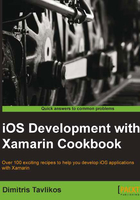
上QQ阅读APP看书,第一时间看更新
Introduction
So far, we have discussed views and how to use them. In most cases of real world app scenarios, views alone are not enough. Apple provides another base class, the UIViewController class, which is responsible for managing views. A view controller can respond to device notifications, such as when the device rotates, or can provide different ways to display and dismiss multiple views or even other view controllers. There are a number of view controllers available for us to use. In this chapter, we will discuss the most important ones.
These view controllers are as follows:
- UIViewController: This is the base class of all view controllers.
- UINavigationController: This is the view controller that provides various ways of navigating through different view controllers.
- UITabBarController: This is a view controller that displays multiple view controllers in a tab-like interface.
- iPad-specific view controllers: These are the view controllers that only apply to the iPad device.
Furthermore, we will learn how to create our own custom view controllers, and we will create an app whose user interface will be created with storyboard files.